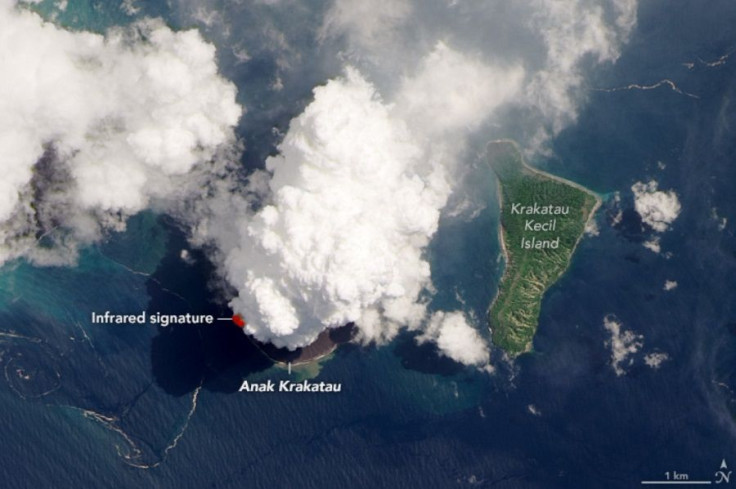NASA Satellite Image Shows Anak Krakatau's Ongoing Eruption
KEY POINTS
- Landsat 8 satellite captured an image of Anak Krakatau just days after the initial eruption
- The white plumes suggested it was composed mostly of water vapor and gas
- Anak Krakatau emerged after the devastating 1883 eruption of Mount Krakatau
Indonesia's Anak Krakatau volcano was showing elevated activity since it erupted twice Friday (April 10). Days after the initial eruption, a satellite captured an image of the volcano as a plume was towering over its peak.
The natural-color image, captured by NASA and the United States Geological Survey’s Landsat 8 satellite, was taken Monday and showed plumes rising from Anak Krakatau in Lampung province. According to volcanologist Verity Flower, the white color of the plume showed it was likely composed of mostly gas and water vapor. If it was composed of ash particles, it would have appeared brown or gray.

That said, there were also parts of the plume that are somewhat darker and lower compared to the white puffs directly over the peak. Flower noted this could be signs of heavier ash particles that were staying lower than the water and gas plume, which were lighter and therefore would be transported higher.
Under the plumes, the image also showed infrared signature in bright orange, possibly showing signs of molten rock.
"Anak Krakatau volcano has displayed these small eruptive bursts periodically through the last few years," Flower said. "However, it can also display more destructive activity such as tsunami-triggering eruptions."
Although residents of Lampung province were used to minor eruptions and rumbles, the 2018 Anak Krakatau eruption was so massive it caused a landslide that collapsed the volcano's entire southwest flank. This then caused a tsunami that killed at least 430 people and injured thousands more.
According to authorities, last Friday's eruption was relatively small compared to the 2018 eruption. However, The Jakarta Post noted three other volcanoes showed elevated activity on the same day that Anak Krakatau erupted, although the four eruptions were said to be unrelated to each other. As a result, authorities declared the second-highest alert status for Mount Kerinci, Mount Semeru, Mount Merapi and Anak Krakatau last Saturday.
Anak Krakatau means "Child of Krakatau." It was named as such because it emerged after the devastating Mount Krakatau eruption in 1883, which left at least 36,000 dead due to a massive tsunami.
It was in 1927 that Anak Krakatau released its first blast on the seafloor from within the caldera. Two years later, its cone peaked above the water for the first time. Since then, Anak Krakatau has been sporadically active, sometimes even spitting clouds of ash into the air for months at a time.
© Copyright IBTimes 2024. All rights reserved.












